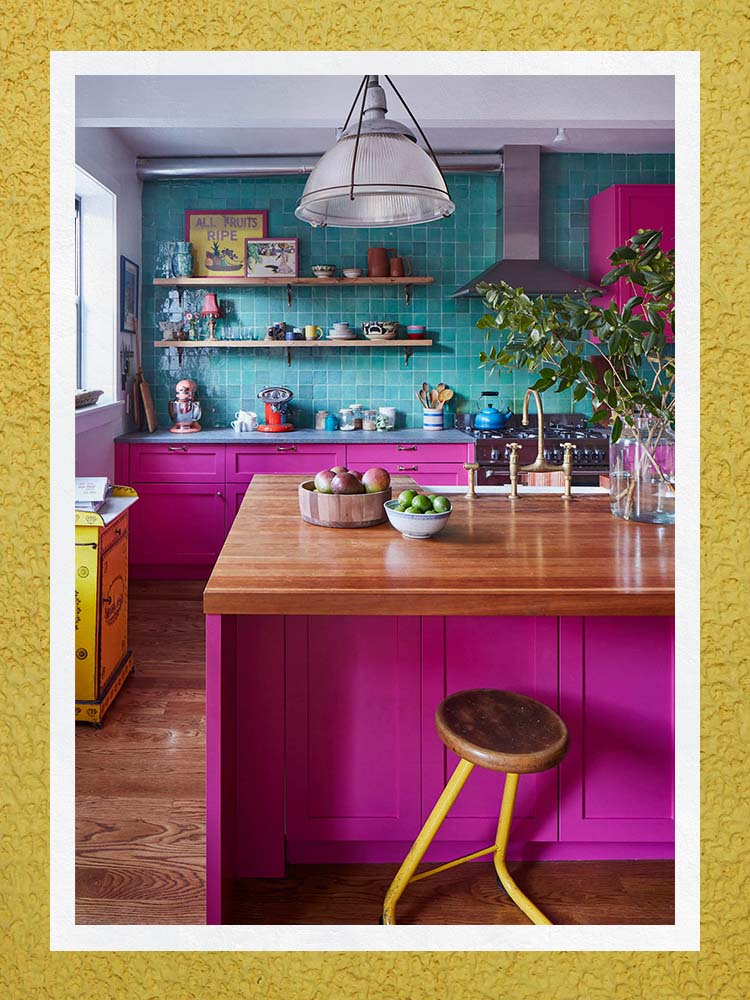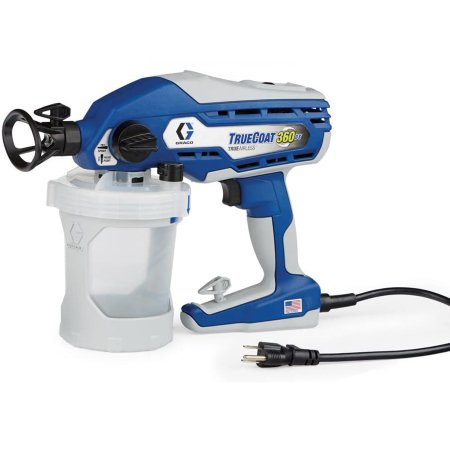We may earn revenue from the products available on this page and participate in affiliate programs.
Reading up on Domino’s shopping guides is like having your own personal product concierge. We do the tedious part—deep-dive research, hands-on testing, and tapping experts for advice—so all you have to do is hit “add to cart.” That’s why we call them Simply the Best.
Painting, we’re told, is supposed to be a low-lift project. But by the time you’ve taped off every corner and completed every finishing touch, you not only tack on extra hours to what was supposed to be a quick and easy DIY, but you can still see every visible brushstroke. However, a streaky finish likely isn’t your fault (or that of the high-quality bucket of paint you splurged on), so you might need to upgrade to one of the best airless paint sprayers.
Garrett Poshusta, one half of the DIY design duo behind Grit and Polish, swears by this professional-grade tool. “When done properly, spraying gives a next-level finish to cabinets, moldings, and woodwork. We’ve sprayed several projects over the years, and there’s really no other way to create that high-end, smooth finish,” he argues. “For the commonly used latex paints and primers, airless paint sprayers are the best option.”
And while our list of the best airless paint sprayers, below, doesn’t include the one Poshusta and his wife, Cathy, currently own (the Graco 190ES, which is in and out of stock), we found a pretty close substitute—and one he’s been eyeing to pick up—to help upgrade your next paint project, based on your skill level.
Our Favorites
- Best pro-level: Graco Magnum ProX19 Cart Airless Paint Sprayer
- Best flexible: Graco Magnum 262800 X5 Stand Airless Paint Sprayer
- Best handheld: Graco TrueCoat 360DS Paint Sprayer
Best Pro-Level: Graco Magnum ProX19 Cart Airless Paint Sprayer
Best Professional
Shop NowAnnual capacity: 500 gallons | Max tip size: .019 | Flow rate: .38 GPM
What we like:
- 150-foot hose (longest on this list)
- Includes metal spray gun
- Often a “one coat and done” level of spray
Worth noting:
- On the pricier side (but reserved for pros or expert DIYers)
Why we chose it: If you already consider yourself a painting purveyor, this tool will take your projects to the next level.
When it comes to finding an alternative for the Poshusta-favorite Graco 190ES, which the couple has owned for roughly seven years with rno issues, we found the brand’s Magnum ProX19 to be a pretty close second. Albeit a bit utilitarian, its cart design is ideal for larger projects, as it can easily wheel around obstacles and take the load off carrying large buckets of paint (up to 5 gallons). By the job’s completion, quickly eject any leftover paint to keep your tool in tip-top shape, and never worry about clogs thanks to a reversible tip. Efficient and powerful enough to use on exteriors, we do think this product is best left to real-deal renovators; if you’re someone who is tackling all sorts of paint projects throughout the year and onward, then this is worth it. (We almost forgot to mention: The ProX19 is compatible with 14 different tip sizes and offers an adjustable pressure gauge, to control the spray.) It otherwise, thanks to the steep price tag and time it takes to learn how to properly operate one, isn’t.
Best Flexible: Graco Magnum X5 Stand Airless Paint Sprayer
Best Flexible
Shop NowAnnual capacity: 125 gallons | Max tip size: .015 | Flow rate: .27 GPM
What we like:
- Lightweight enough to carry
- Adjustable paint flow
- Maximum 3,000 PSI
- Corrosion-resistant spring guards
Worth noting:
- 50-foot cord and 75-foot hose (but you can buy extensions)
Why we chose it: A lightweight, more affordable option compared to a pro-grade sprayer, but still just as high quality.
This was Poshusta’s answer to what kind of airless paint sprayer he’d get now (that and this Himalaya airless sprayer). “I’d definitely get one with a flexible tube that allows for suction right off the can and is more compact in size,” he shares. This is a great option for homeowners who have occasional use for one, he adds. And it’s pretty powerful for its size; at 19 pounds, it’s light enough for most people to carry from room to room. All you have to do is add this to a bucket and you’re good to go. Even compared to the commercial-grade Magnums (such as the GMAX and Pro), it provides the same 3,000 PSI output; the only difference, really, is its smaller annual capacity. Another notable bonus: We love that it can be hooked up to a garden hose to flush out left-behind paint, making cleanup a breeze and ensuring the prevention of future clogs.
Best Handheld: Graco TrueCoat 360DS Paint Sprayer
Best Handheld
Shop NowAnnual capacity: 25 gallons | Max tip size: 1.5 | Flow rate: .2 GPM
What we like:
- Only 4.5 pounds
- 2 simple speed options
- 32-ounce paint bag that can be washed and reused
- Great for smaller projects
Worth noting:
- Limiting cord (just 18 inches)
Why we chose it: Take control of smaller projects with this “easier”-to-use sprayer.
For the beginner DIYer ready for the next step and with only a few projects planned, a handheld sprayer is likely all you need (and perhaps your gateway into larger airless paint sprayers down the road). Easier to control—as it offers lower maximum pressure—you can flip this tool in any direction, even upside down, without having to worry about overspray too much or going back in with a brush in those harder-to-reach areas later on. Despite its size, this handheld sprayer still offers plenty of customizable features to get the finish you want, whether that’s through adjustable speeds or two reversible spray tips (4-inch- and 12-inch-wide options). Graco’s customer service is top-notch, so don’t be afraid to reach out if you happen to run into any issues either. Plus if the short cord makes you nervous, you can always upgrade to the Graco Ultra (though it’ll likely cost you upwards of $100 extra).
How to Get That No-Streak, Pro-Painter Finish
Not sure where to start? Here are Poshusta’s top suggestions:
- You can get tip extensions for your spray gun, which will allow you to paint ceilings without a ladder. These work really well when painting larger areas.
- The hardest part of spraying is getting even coverage. Multiple lighter coats will minimize drips and inconsistencies.
- If you lay surfaces like cabinet doors or drawers horizontally while painting, you’ll minimize the chances of drips.
How We Chose These Products
Zach Kenney, president of ZK Painting—one of just 13 companies that is Fine Paints of Europe Master certified—provided his recommendations of the best paint sprayers, and we rounded out the list with picks from DIYer Poshusta, prioritizing the following aspects: flexibility (being able to easily navigate around tight corners of a project or move the sprayer from room to room), variety of tip sizes, and adjustable flow rates. These products definitely don’t fall under an entry-level category (especially when it comes to skill set)—so know that you’ll have to invest money and time to use them properly before getting started.
Our Shopping Checklist
Types of Paint Sprayers
As Kenney has told us before, on a scale from beginner to expert, paint sprayers are pretty advanced. The two different types to choose from include airless and high volume low pressure (HVLP). The latter emits a lot of air, but at a superlow pressure, which makes it much easier to control (especially from a handheld perspective). These are great for smaller projects, like a single piece of furniture. But for larger projects, such as redoing an entire kitchen (cabinets and all), an airless paint sprayer will definitely come in handy.
Airless paint sprayers project air at a superhigh pressure—as in, the same amount as hard-core pressure washers—through a tiny hole that atomizes the paint. That means these types of sprayers put out significantly more paint at a much faster rate compared to other, popular options.
Tip Size
Tip size refers to the hole that the paint is pushed through, and it will determine how much fluid leaves at a time, usually defined by a three-digit code. “The first number is the fan-width pattern, which is twice the number, and the second tells you the orifice size,” offers Kenney. “So if the tip number is 3.12, it’s a 6-inch-wide pattern with a 12-millimeter orifice.”
According to Graco, you’ll want a tip size between .013 and .015 for oil-based paint, whereas for latex paint you’ll want to aim between .015 and .019. Or, refer to their handy calculator for something more precise.
Power Source
Most airless paint sprayers are eclectric and, in order to be used, have to be plugged into an outlet. That’s why the length of the hose is so important, as your movements may be restricted by how far you can reach in addition to the distance from an outlet.
When it comes to larger, contractor-grade equipment, you may notice that the spraying stands come with wheels for better mobility, ideal when covering a large surface like an exterior of a house.
Ask Domino
Q: How can I figure out if my project is better suited for an airless paint sprayer over HVLP?
It all comes down to size. Consider how much paint your entire project will require. If it’s more than one gallon, experts advise that upgrading to an airless machine may be worth it.
Q: Do airless sprayers create overspray?
One hundred percent. And it’s something you’ll need to be incredibly conscious of. This is why properly preparing a space by either taping or masking off every surface is so vital; paint can end up anywhere, especially if you’re working outdoors.
“Anything in the room (and adjoining rooms if not sealed off!) will be covered in a fine layer of aerosolized paint particles, so make sure all surfaces, including the floors, are covered,” Poshusta stresses, recommending Scotch Blue’s all-in-one dispenser as a time-saver. “The spray has enough force to blow heavy drop cloths and cardboard around if they aren’t fixed in place.” He uses plastic on windows and doors and paper on floor edges—and he masks the floor and wall edges with 9-inch-wide paper taped along the paint edge.
Q: Which is better: spraying paint or using a roller?
This really depends. What’s most important to you (time versus finish)? Or what are you most comfortable using? While the best airless paint sprayers can save you both time and money in the long run and provide that slick, pro look, achieving that finish takes a lot of practice. After all, there’s a reason there are professional painters out there. If you’ve struggled with paintbrushes or rollers in the past, then why not give a sprayer a try?
The Last Word
The best airless paint sprayers aren’t cheap or quick to master. This is a worthwhile purchase only if you’re willing to invest time and effort, in addition to money. But the payoff? It’s unmatched compared to other painting accessories—especially if you foresee having more than one big project planned in the coming years. You can tap this tool for a variety of DIYs, whether you need to refresh the stain on your fence, love to change up the hue of your bedroom, or aim to redo every cabinet in your new kitchen. Our favorites range from professional to beginner in both size and scope.




